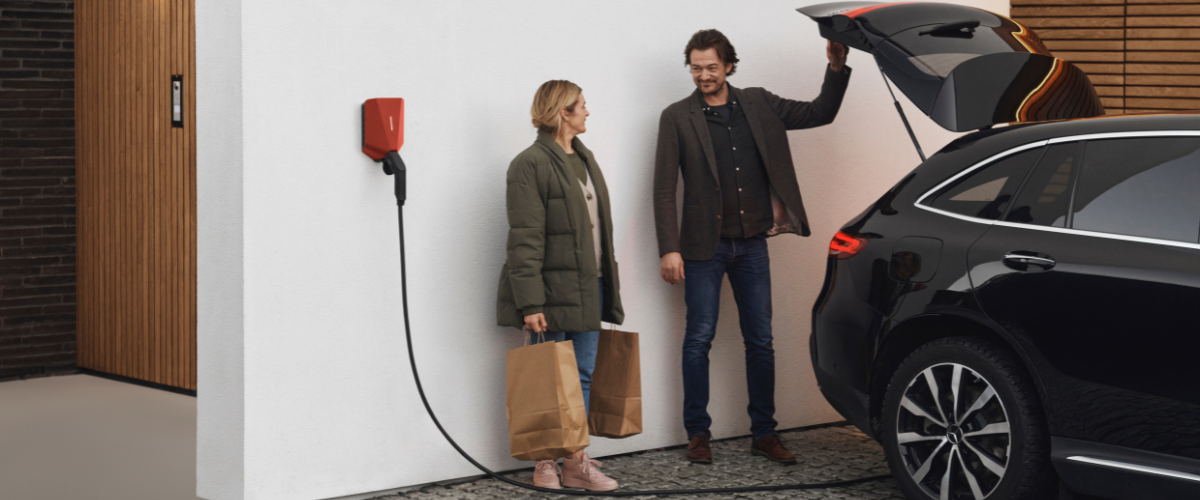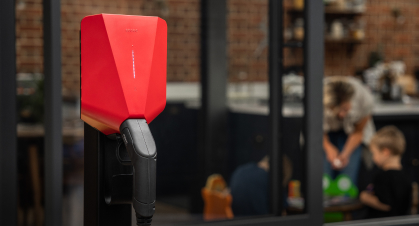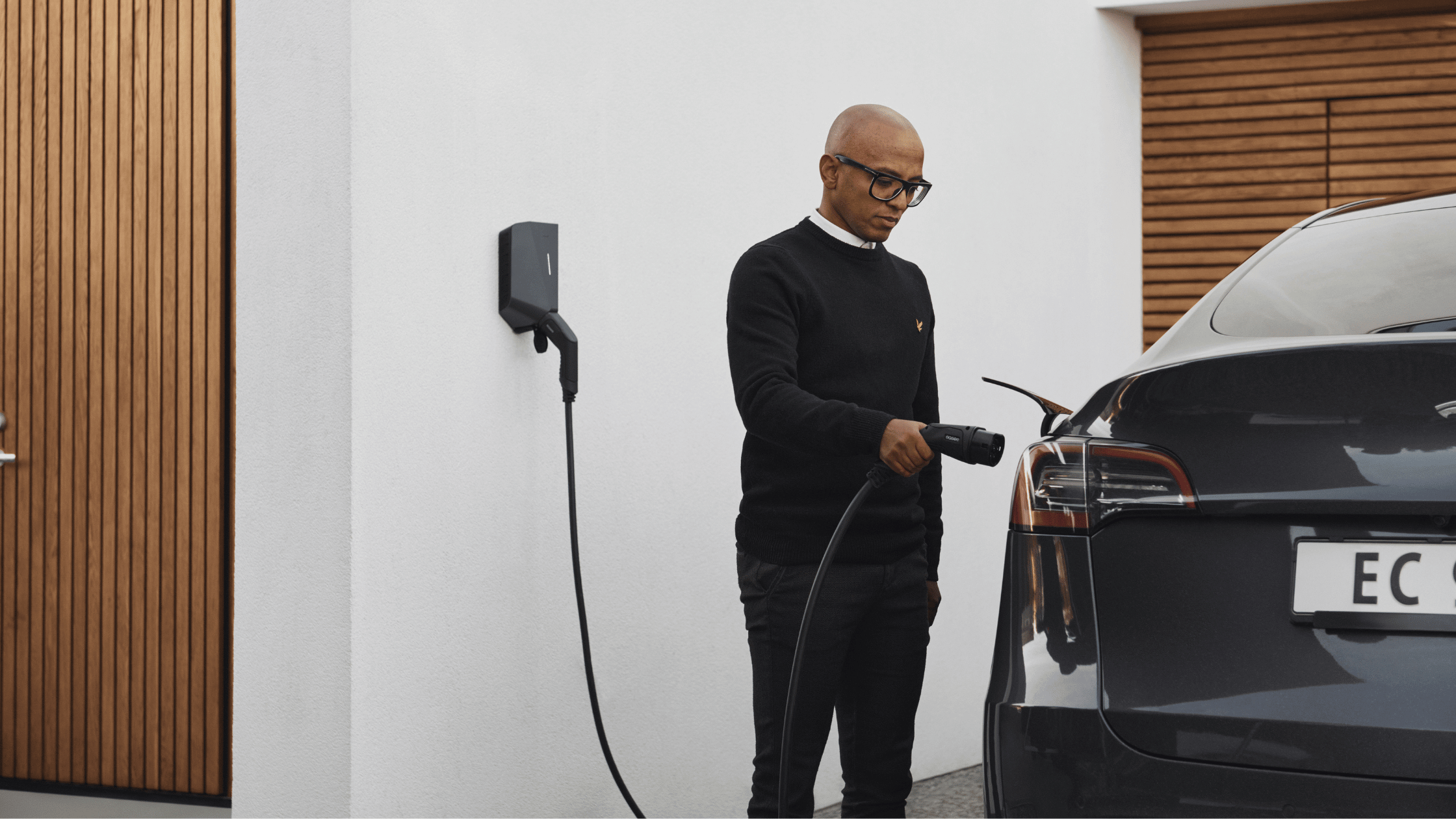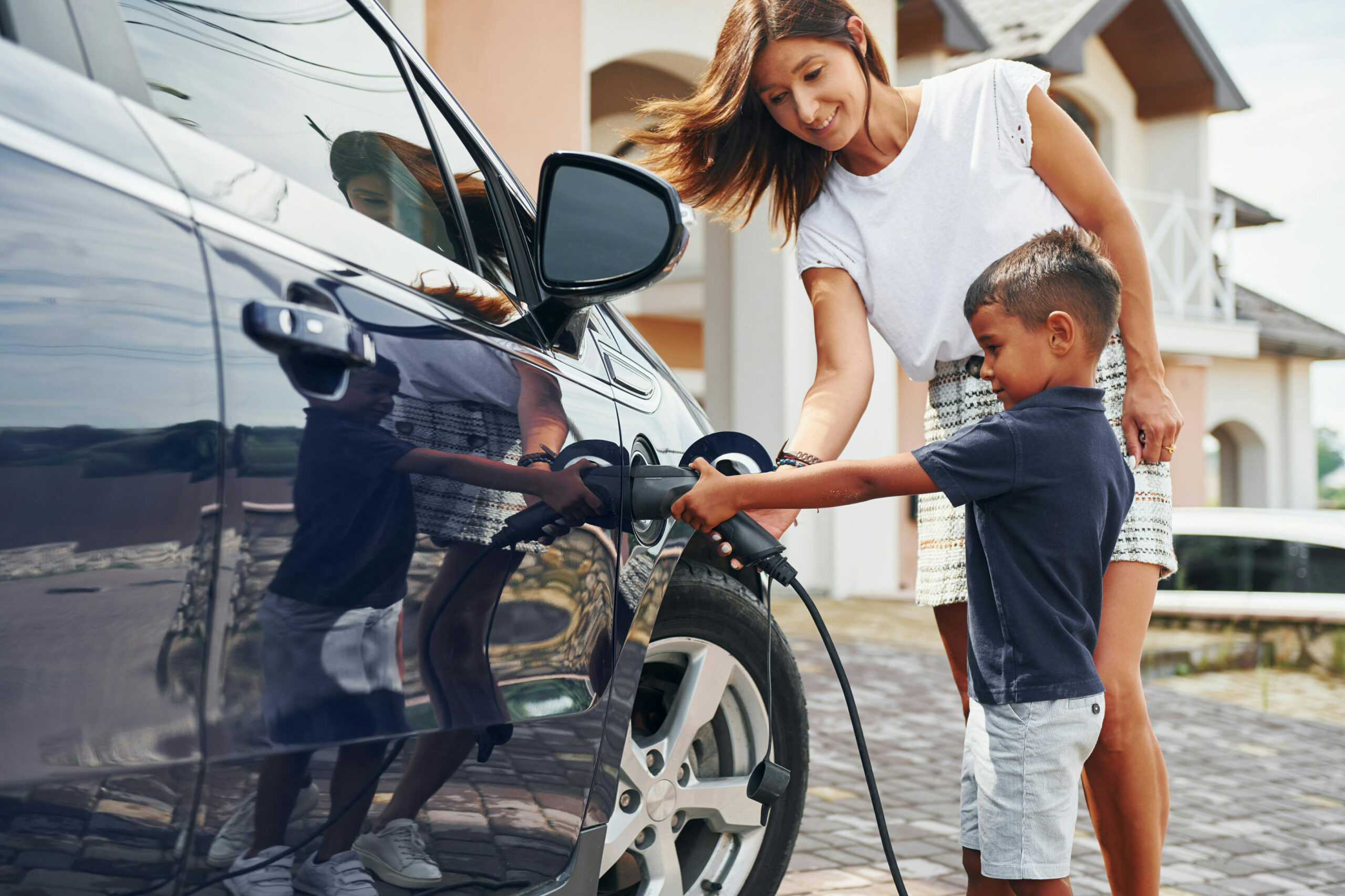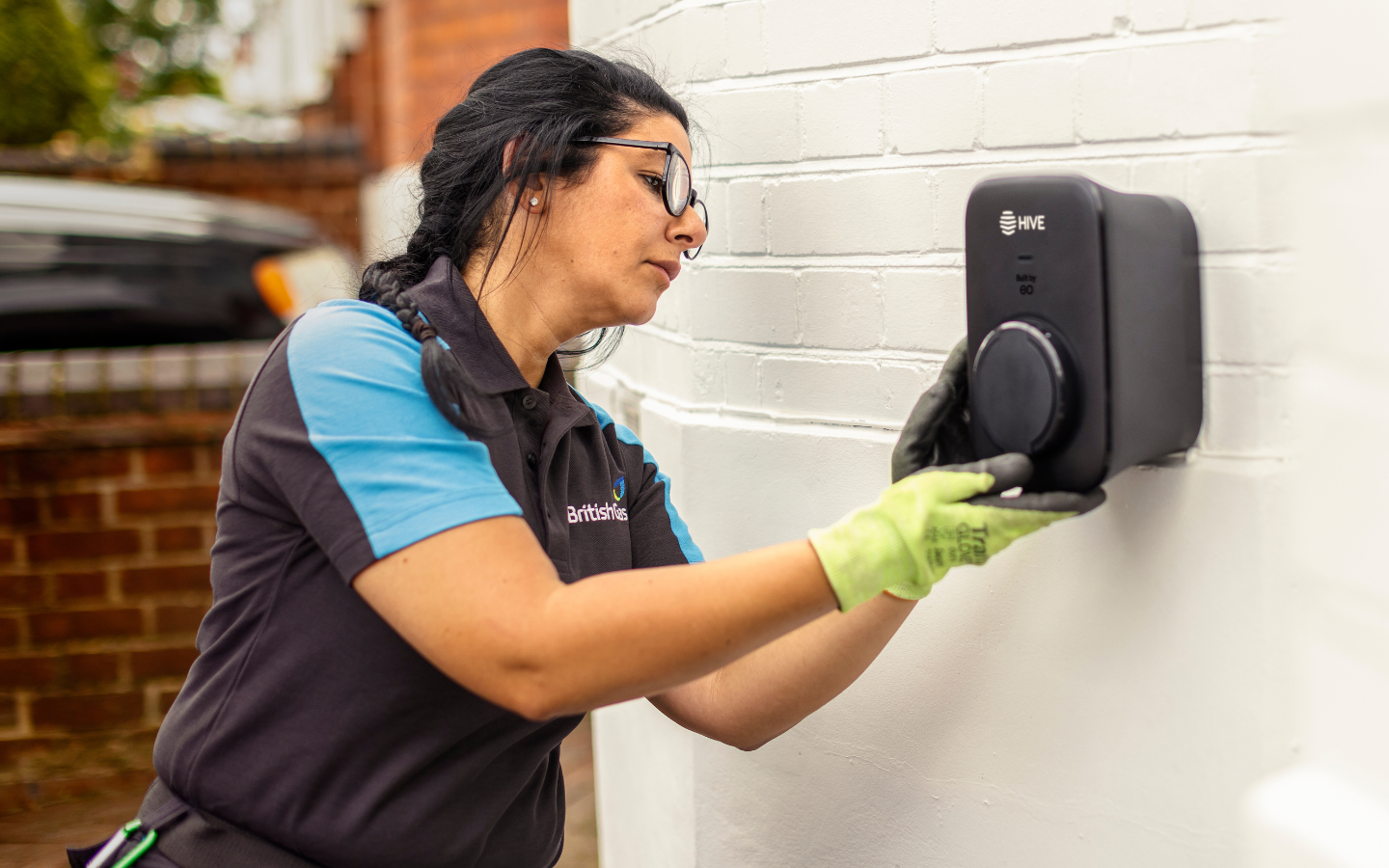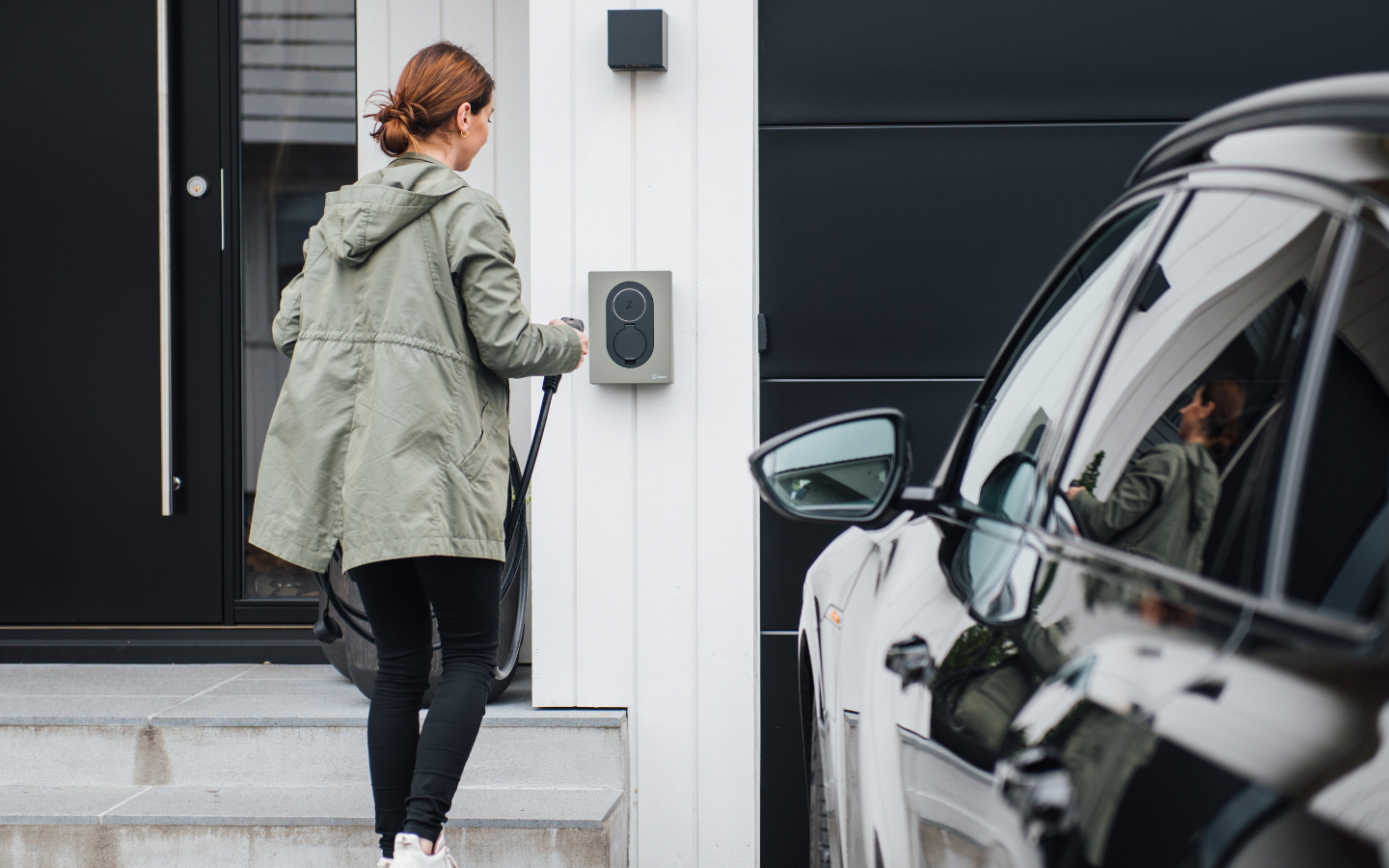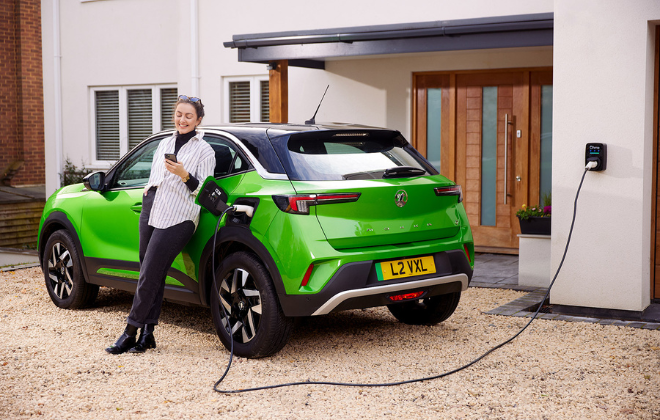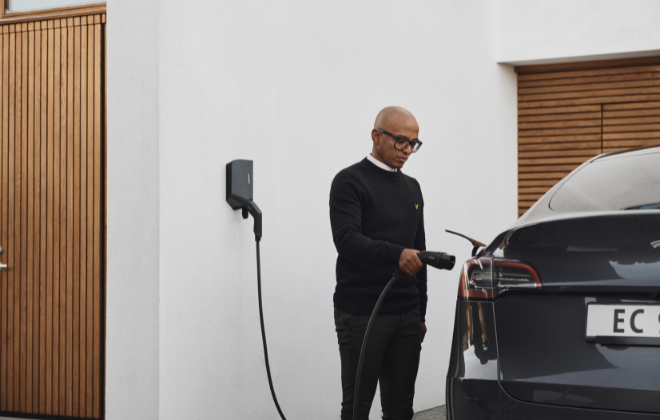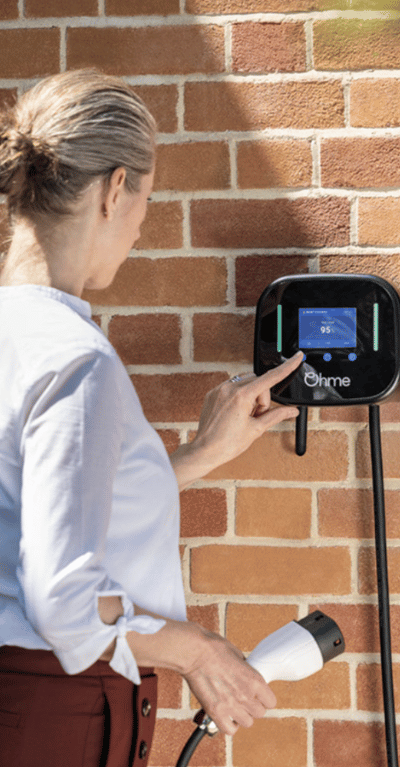
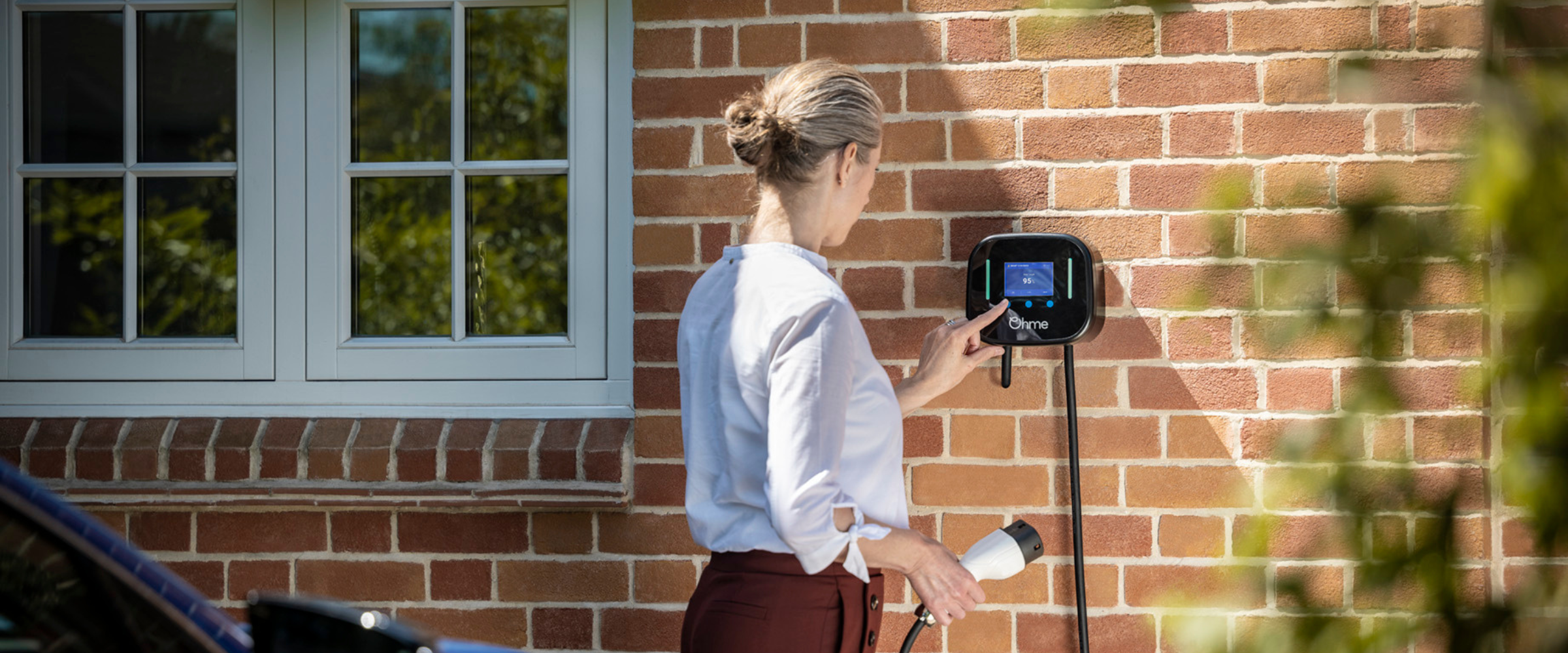
FAQs_
Charging
What is ChargePlace Scotland?
ChargePlace Scotland is a network of public charging stations in Scotland – many of which are free.
What happens if my EV charger stops working?
If your EV charger was installed by us and, in a rare instance, stops working, we recommend checking the troubleshooting section on the manufacturer’s website and the manual given during your installation handover.
If you are still encountering issues with your EV charger after checking the relevant resources, please don’t hesitate to contact us. With expert engineers nationwide and support seven days a week, we are there for you before, during, and after your installation.
How many amps does a home EV charger use?
A standard 7kW home EV charger uses 32 amps.
Do new build houses have to have EV chargers?
Since June 2022, all new built homes and commercial buildings in England with associated parking became legally required to have EV charging points as part of the Part S building regulations.
Learn more about new build houses and EV chargers.
Can I charge my EV in the rain?
You can charge your electric car no matter the weather due to the high IP ratings of all properly manufactured smart EV chargers.
What is an electric car onboard charger?
An electric car’s onboard charger converts AC energy into DC energy when you plug in to charge at home or at certain lower-rated public charging points since electric car batteries can only charge with DC electricity. With this, there is a maximum amount of energy the onboard charger can convert, making this the maximum rate you can charge your EV with at an AC charging point. For example, if your electric car’s maximum onboard charging rate is 11kW, while you can still plug in to charge at 22kW AC, you won’t charge any faster than 11kW.
How do you maintain your EV charger?
EV chargers need little – if any – maintenance as they are built to last, ensuring high IP ratings for durable, weatherproof technology.
But, to keep your EV charger in the best condition, it’s best practice to regularly clean your EV charger, cord, and connectors. Check the charging cable for wear and damage, and monitor for any signs of slow charging, too.
How do I know which EV charger to choose?
We offer a wide range of market-leading EV chargers to cater to all EV charging needs. Review blogs, videos and more to help make an informed decision, or contact our knowledgeable team seven days a week for unbiased advice, recommendations and insights tailored to your preferences and requirements to find your ideal match.
Which is the best EV charger?
There is no best EV charger—each has different smart functionalities, styles, charging outputs, and more, meaning the best EV charger for one person may be different from another.
However, at We Power Your Car, we have tried, tested and hand-selected some of the best EV chargers on the market to make your decision easier.
What is load management or load balancing?
An EV charger that has load balancing or load management ensures safe energy distribution between your EV charger and other appliances. Your EV charger will dynamically change its maximum power depending on how much is used elsewhere in your home to protect the main fuse from blowing.
Can I charge my electric car with solar energy?
It is possible to charge your electric car with solar energy. To do so, you will need a solar PV system and a solar-compatible EV charger. The number of solar panels required depends on your EV’s battery size and your home’s energy usage, but eight to ten is usually the sweet spot. Charging times also vary based on the solar array size and daily solar production.
How secure is my EV charger?
Technically, it is possible to steal electricity from a home EV charger. However, the chances of this happening are small (any perpetrator would have to park up and leave their car on your drive to do so).
In our time working in this industry, EV charger and charge theft is not something we’ve encountered. But if you want additional peace of mind, certain home chargers do have built-in locking mechanisms or smart features where user access can be controlled.
Charging cables are not cheap, so if your charge point is easily accessible, then store the cable securely when it’s not in use.
When should I charge my electric car?
For the most convenient and highest cost savings, charge your EV overnight at home during off-peak hours.
Do EV chargers need Wi-Fi?
A smart EV charger needs to be installed somewhere where there is either a stable Wi-Fi connection or a mobile connection to function properly and be compliant with the smart charging regulations.
If I move house, can I take the charger with me?
Yes, you can bring your original EV charger with you when you move house, but it may be cheaper to purchase a new one.
Grants, permissions, DNO approval, charger warranty, installer willingness, and other factors need to be considered before making the decision.
At We Power Your Car, our engineers are happy to relocate your old EV charger or install a new one.
How often should I charge my electric car?
How often you charge your EV depends on your driving needs and car range. Regular nightly charging is not necessary for average use.
Can I leave my EV to charge overnight?
Yes, you can leave your EV to charge overnight with a smart EV charger. Modern electric vehicles are equipped with advanced charging management systems that prevent overcharging. In fact, they slow down charging as the battery fills, then switch to trickle charging to keep the battery healthy.
Should I keep my EV fully charged?
No – consistently fully charging your EV can degrade your battery quicker, decreasing your electric car’s overall range over time. Industry experts recommend keeping your EV battery between 20% and 80% state of charge to preserve performance and EV health.
Do I need multiple EV chargers for a household with two or more electric vehicles?
It’s unlikely that you will need two EV chargers at home as you can rotate who uses the charger in a multi-EV household. That said, if you want to, you can have two charging points, whether at home or elsewhere, such as at the workplace. But, if you use both EV chargers at the same time on a single-phase electricity supply, then the power output will be split at around 3.6kW each – charging slower than normal.
Ultimately, the decision needs to be based on a number of factors, such as cost, space, charging speed and how frequently you use your electric car.
What length of EV charger cable should I choose for my home EV charger?
The ideal home EV charger cable length is usually between 5 to 10 meters, depending on your specific needs. However, consider the distance between your car and the charger before making a decision, or ask a member of our team for help.
Is it worth installing an EV charger at home?
A home EV charger provides an abundance of benefits, from more convenient charging from the comfort of your own home to cheaper EV charging sessions through smart features. Home EV chargers provide benefits that the public and 3-pin charging can’t compete with.
Home EV chargers also add an extra layer of security and safety when compared to using granny chargers at home.
Learn more about the benefits of installing a home EV charger.
What's the difference between Type 1 and Type 2 EV chargers?
Type 1 and Type 2 EV chargers differ in their pin design, regional use, and charging speed.
Type 1 chargers have five pins and are typically used in North America and Asia. They are suitable only for single-phase electricity and can’t lock. On the other hand, Type 2 chargers, which are the most common in the UK and Europe, have a seven-pin design, support single and three-phase electricity for faster charging, and feature a locking mechanism.
If I change electric cars in the future, will the EV charger still work?
It depends. Our EV chargers are universally compatible with all electric vehicle brands and types. For your car to correctly charge, though, your electric car and charger must have matching connectors so you can plug in.
For example, most modern EVs use a Type 2 socket, which works with all the chargers in our range. So, if you have a new EV with a Type 2 connector, then your car will work with your charger.
However, if your new car has a Type 1 socket, you’ll need a socketed type 2 charger and a Type 2 to Type 1 adapter for charging.
It’s unlikely this will happen as most modern EVs typically have a Type 2 socket – but it is something to be aware of.
How long does it take to charge an electric car with a 22kW charger?
On average, a 22kW charger will charge your EV in 3-4 hours.
How long does it take to charge an electric car with an 11kW charger?
11kW EV charges add around 38-40 miles of range, charging your electric car from full to empty in around 6 hours.
How long does it take to charge an electric car with a 7kW charger?
A typical 7kW home charger adds 25-30 miles of range per hour, resulting in an average 7-8 hour charging time for electric cars from empty to full.
How long does it take to charge an electric car with a 3.6kW charger?
A 3.6kW car charger can take from nine to fifteen hours to charge your electric car.
How long does it take to charge an electric car with a 3-pin plug?
A three-pin plug charger, or granny charger, can take between 15 to over 20 hours to fully charge your electric car at a rate of 2.3kW.
How long will it take to charge my electric vehicle?
An electric vehicle’s charging time depends on the battery size of the electric vehicle, the charging speed of the charger and other external factors such as weather.
EVs can be charged in a quick 30-minute period at rapid and ultra-rapid EV charging stations or for a longer 18-hour period using 3-pin plug chargers, depending on these factors.
What's the difference between slow, fast and rapid EV charging?
Slow charging, sometimes referred to as Level 1 charging, typically ranges from 2.3kW to 3.6kW and is the slowest way to charge your EV.
Fast, or Level 2, EV charging includes 7kW, 11kW, and 22kW chargers. Fast EV chargers are more commonly found in homes, but they can appear in public locations.
Rapid EV charging is considered charging with power outputs of 43kW up to 50kW. Ultra-rapid EV chargers can range from 50kW up to 350kW. Rapid and ultra-rapid EV chargers are classed as Level 3 EV charging and can often charge your EV to 80% in about 20 to 40 minutes.
What's the difference between a tethered and untethered EV charger?
A tethered EV charger has the charging cable permanently attached, whereas you use your own cable with an untethered or socketed. Every time you want to charge, you have to connect and disconnect the charging cable.
One type of EV charger is not better than the other. It’s a personal choice as to which you choose. Untethered EV chargers offer more flexibility, while tethered chargers offer more convenience.
What home EV charger power outputs are available?
The most common power output for a home EV charger ranges between 7kW to 7.4kW since most homes in the UK have single-phase electricity supplies, and 7.4kW is the highest power output available on this type of supply.
However, the following EV charger power outputs are available to be installed:
Please note that DC rapid and ultra-rapid EV charging points that you find in public cannot be installed at home.
Can I have a home EV charger if I have on-street parking?
Yes, although you will need to invest in an additional cross-pavement charging solution beforehand, such as a ChargeArm, to be able to have a home EV charger installed.
Currently, there is a £350 grant that helps EV drivers with on-street parking to invest in a home EV charger and cross-pavement solution.
Can I have a home EV charger?
You can have a smart EV charger installed at home if:
- You have designated off-street parking (such as a garage or driveway)
- Own the property or have obtained permission from the relevant party
- Have a stable Wi-Fi or 4G connection for smart functionality to work
What's the difference between a three-pin plug EV charger and a dedicated smart home charger?
Three-pin plug EV chargers, sometimes referred to as granny chargers, are not meant for continuous use. In fact, they are only meant for emergency scenarios when you need to charge your EV but do not have access to a charging point.
A dedicated smart EV charger has a number of advantages over a three-pin plug charger. Here are a few:
Charging speed: Smart EV chargers are over three times faster than three-pin plugs at a rate of 7kW compared to 2.3kW.
Convenience: Smart chargers are more convenient, eliminating the need for extension cables and wiring across driveways and through windows.
Smart features: Smart EV chargers come in-built with advanced smart features such as charge scheduling, which can help you save significantly on home EV charging costs. Some EV chargers even allow you to top-up with solar energy or sync with your energy tariff to find the cheapest prices for you. Smart features are not available with three-pin plugs due to its basic design.
Safety: Smart EV chargers are built with longevity and safety in mind. With high IP ratings, home EV chargers are safe to use both inside and outside, no matter the weather. Each charger undergoes rigorous testing and is built to meet government rules and regulations, protecting your electric car, charger, and home with the highest quality.
Style: Smart EV chargers come in different sizes and styles to match the aesthetics of your home.
Learn more about the differences between a home EV charger and a 3-pin plug EV charger.
What is a smart EV charger?
A smart EV charger is an EV charging unit installed on your property that has smart functionality. Smart functionality has different definitions, but it typically means there’s connectivity between your charger, electric car and an app through a Wi-Fi or mobile connection.
With this connection, you can manage your EV charging remotely and access a selection of smart charging features that make charging sessions cheaper and more convenient. Each charger has different smart features, with some offering the ability to charge with free surplus solar energy and others that allow you to sync your EV charger with your energy tariff for cheap energy prices.
EV chargers must have smart functionality in order to be compliant with the government’s smart EV charging regulations.
Are EV chargers AC or DC?
Electric cars always store DC energy; however, EV chargers can be either Alternating Current (AC) or Direct Current (DC).
Home EV chargers will always use AC, whereas public chargers can be either AC or DC.
Learn more about the difference between AC and DC EV charging.
Are all EV chargers the same?
No, not only do EV chargers come in different shapes and sizes, but they also differ in smart functionality, power output, and connector type. In short, there’s no one-size-fits-all EV charger – the decision is based on your individual needs and requirements.
What's an RFID card?
An EV RFID card uses Radio-Frequency IDentification technology to stop and start EV charging sessions. RFID cards are sometimes referred to as EV charging cards, tags, or keys, but all use Radio Frequency technology to manage the electric car charger in use.
RFID cards are not essential, but they do offer more flexibility.
Where can I charge my EV?
Charge at home, at your workplace, on your journey – wherever you can find a suitable charger for your EV.
With the number of EV charging stations rapidly increasing across the UK, you can locate your nearest public charging point by using popular EV charging apps such as Zap-Map.
That said, home charging is more convenient and cost-effective. A car is stationary for 90% of its lifetime, and over 70% of that time is at home.
While limited, free public EV chargers are available in some areas.
Electric Vehicle
Is it worth investing in a second hand electric car?
Yes – second-hand electric cars provide all the perks of EVs at a fraction of the price.
Do you pay VAT on electric cars?
Yes, just like all vehicles, you pay a 20% VAT charge on any type of electric vehicle.
Are electric cars exempt from the Ultra Low Emission Zone?
Battery electric cars are exempt from the Ultra Low Emission Zone; however, hybrids are subject to the £12.50 daily fee.
Learn more about electric cars and the ultra-low emission zone.
Are electric cars exempt from the Congestion Charge?
Pure electric cars (battery or ‘fully’ electric vehicles) are exempt from the Congestion Charge, while hybrid and plug-in hybrid electric cars are not.
Do electric cars need an MOT?
Just like all vehicles in the UK, electric cars need yearly MOTs if the car is over three years old.
Learn more about electric car MOT – including costs and where to book.
What are the benefits of electric cars?
Electric cars have several benefits, including eco-friendly driving with zero carbon emissions at the tailpipe, smoother driving, and cheaper running costs – to name a few.
Do you still have to pay road tax for an EV?
To date, battery electric vehicles are exempt from road tax and the added expensive car supplement for vehicles over £40,000.
However, this will change in April 2025, when EVs will start being taxed and be subject to the expensive car supplement if the EV exceeds £40,000.
It’s important to note that plug-in hybrid electric vehicles (PHEVs) do have to pay road tax and will continue to pay road tax in the future. Hybrids also currently pay an extra premium for those over £40,000 due to their CO2 emissions.
Do EVs need less maintenance?
Typically, EVs need less maintenance than petrol and diesel cars because they have fewer moving parts.
That said, EVs still need regular checks of tyres, air filters, and wiper blades to ensure the best condition.
Do electric cars use oil?
In short, battery electric cars do not use engine oil as they do not have an internal combustion engine. However, other oil changes are needed.
Do electric cars have exhausts?
Since electric cars are zero-emission at the tailpipe, they do not need to have functioning exhausts.
Can I buy a manual electric car?
No, manual electric cars are not available because electric vehicles do not need gears to function, making all electric cars automatic.
Can an electric car tow a caravan?
Technically, an electric car can tow a caravan —but not all electric cars and plug-in hybrids are legally allowed to do so. Check if the specific vehicle is approved for towing and what its towing capacity is.
What is the green strip on some electric vehicles?
The green strip on some UK number plates indicates that the vehicle is zero-emission.
When will all cars be electric in the UK?
With the 2035 ban on the sale of new petrol and diesel vehicles in the UK, it’s likely that most cars will be electric around 2035 and onwards. That said, the EV adoption rate is increasing month on month, with over 1,110,000 pure EVs on UK roads to date according to Zap-Map.
Learn more about the 2035 ban on the sale of new petrol and diesel vehicles.
How long do electric car batteries last?
EV batteries can last between 10 and 20 years or upwards of 100,000 miles.
Will an electric car increase my electricity bill?
On average, owning an electric car raises your home electricity bill by 10-15%. That’s an extra £7.50 for every £50 of electricity.
That said, home EV charging costs will vary depending on your electricity provider, tariff, when you charge, and whether you use any smart features.
For example, EV owners can take advantage of the charge scheduling feature that comes standard with all smart EV chargers. Set your car to automatically charge during off-peak hours (overnight at 12am-5am) and save significantly on home charging costs.
To add to this, you could combine a solar PV system and a solar-compatible smart charger to top up with free solar energy. Or you can invest in a home EV charger with advanced tariff compatibility, such as the Ohme Home Pro, which can sync with your energy tariff and automatically charge at the cheapest rates available to you.
How much does it cost to charge an electric car?
The cost of an EV journey varies depending on the vehicle you drive – for example, EVs with larger batteries will cost more to fill. But there is a simple formula to work out how much you will pay to charge your electric car.
The size of the battery (kWh) x the electricity cost of your supplier (pence per kilowatt-hour) = the cost of charging an electric car from empty to full.
What does kW and kWh mean for electric cars?
A kW stands for kilowatts and is a power unit that measures the rate at which energy is consumed or produced. For electric cars, kW specifically represents the rate of power from the charger to the EV battery, indicating how quickly the charging station can charge your car—for example, 3.6kW, 7kW, 11kW, or 22kW.
On the other hand, kWh stands for kilowatt-hour and indicates how much energy your EV battery can store, therefore showing your electric car’s total range.
Learn more about kilowatts and kilowatt hours in relation to EVs.
What are the running costs for an electric vehicle?
Running an electric vehicle is typically cheaper compared to a petrol or diesel car. Free parking in certain areas, no road tax, and lower emissions are some of the costs that electric cars don’t have. Add in the potential savings with home EV charging, and you will find that running an EV is cheaper than a petrol car.
What is an electric car salary sacrifice scheme?
An EV salary sacrifice scheme allows employees to exchange a portion of their salary for access to an electric car. These schemes offer benefits to both employees and employers, including tax savings.
Learn more about the benefits of EV salary sacrifice schemes.
How can I afford an electric car?
There are multiple ways to afford an electric car in 2024 without paying the high upfront cost of a brand-new one. You can invest in a second-hand electric car, lease an electric vehicle, take advantage of an EV salary sacrifice scheme, undertake a monthly EV subscription, or purchase your EV during price cuts.
Learn more about the ways you can afford an electric car in 2024.
Are electric cars more expensive to buy?
Although electric cars may initially cost more to buy outright than petrol or diesel cars in 2024, they have lower operational costs and the potential for long-term savings, especially with a home EV charger, making them cost-effective choices over time.
What’s more, with the introduction of Chinese manufacturers such as BYD, the cost of new electric cars is coming down.
How far can an electric car go on a single charge?
How far an EV can go on a single charge varies and depends on the type of vehicle you’re driving, how you drive it, and the conditions you’re driving it in—just like a petrol or diesel vehicle.
As battery technology improves, the distance a single charge can cover is increasing with every new model. Today, most electric cars have a range of 200-300 miles. For instance, an MG4 can travel up to 281 miles on a single charge.
Learn more about how far an electric car can go on one charge.
What is the difference between electric, hybrid and plug-in hybrid vehicles?
Hybrid electric cars use an internal combustion engine (found in petrol and diesel cars) coupled with an electric motor and a small battery for propulsion. Primarily, hybrids rely on the gasoline engine to move and only occasionally use the electric motor. These mild-hybrids, or self-charging hybrids, can’t be charged with an external EV charger and, in fact, re-gain lost energy during the deceleration and braking processes.
Plug-in hybrid electric cars also have a fossil fuel engine and an electric motor, but unlike hybrids, they have bigger batteries that can be charged at an EV charging point. The plug-in hybrid prioritises driving with electricity before switching to an internal combustion engine when the charge is low, allowing for an extended electric-only driving range.
Lastly, battery electric cars solely rely on electric power stored in large batteries and an electric motor. With no internal combustion engine, battery electric cars offer zero-emission at the tailpipe. An EV’s battery must be recharged from an EV charger, as there is no petrol or diesel engine in a fully electric car as a backup when the charge is low.
What is an electric vehicle?
An electric vehicle is any vehicle that uses an electric motor for propulsion.
There are three types of electric vehicles:
BEV – Battery electric vehicle (sometimes referred to as a fully electric car, pure electric car or EV)
PHEV – Plug-in hybrid vehicle
HEV – Hybrid electric vehicle
EV charger installation
Is there a warranty on my EV charger?
Yes, all our products come with a minimum 3-year manufacturer warranty, providing complete peace of mind.
How do you handle maintenance and support after installation?
Our UK-based customer service team is here for you seven days a week, even on bank holidays. We promptly address maintenance issues to ensure uninterrupted charging before, during, and after installation.
Firstly, we start by running remote diagnostics to see if we can resolve the issues. But if needed, our expert installers will come to the site to fix the problems.
What will happen on the day of installation?
On the installation day, you won’t have to do a thing – simply leave our expert installers to it.
Once completed, the engineer will demonstrate how the charger works, including setting up any mobile apps that come with the charger. Feel free to ask any questions about your installation or your charger. Our engineers will be happy to help.
Will the engineer need access to my property on installation day?
Yes, the engineer will need access to your property’s mains distribution board and electricity meter, which may be inside your property.
Your engineer will require the electricity to be turned off, typically for a maximum of 30 minutes.
Do I need to do anything before the installation?
Please ensure you are at the property on the day of the installation and that there are no obstructions in the engineer’s work area. Also, please have your Wi-Fi password ready so the installer can connect your EV charger to the internet (if required). Details will not be kept.
Can I choose when the installation will take place?
We do our best to accommodate your preferred dates, but sometimes, this may not be feasible. However, if your proposed installation date doesn’t work for you, we can work together to reschedule.
How long does it take to install an EV charger?
On average, a standard home EV charger installation takes between 2 to 3 hours.
Learn more about how long it takes to install an EV charger.
When should you buy a home EV charger?
To avoid disappointment due to the rising demand for EV chargers and the fluctuation of DNO timelines, we recommend ordering your EV charger after placing your electric car order or once your car has arrived.
What is a DNO, and how can DNO approval affect my installation?
A Distribution Network Operator (DNO) manages the electricity distribution from the national grid to homes and businesses.
DNO approval is a requirement for every EV charger installation in the UK to ensure your local network can handle the demand of an EV charger. Gaining approval can take weeks and, in unfortunate cases, months. Potential delays can also occur if additional work is needed on your property before we can install your charger. For example, if you need a fuse upgrade or your supply needs unlooping.
We have no control over the DNO approval process or how long additional work can take, and unfortunately, we cannot influence DNO-related delays. We can only offer an installation date once we have received the go-ahead from the DNO.
Please be aware that while most DNO work won’t incur any charges, in some cases, you may be responsible for any DNO costs.
How long will it take to get the EV charger installed from the point of payment?
We aim to install your EV charger as soon as possible once your order has been confirmed. However, the timeline depends on your local distribution network operator’s (DNO) approval.
Why do I have to complete the remote site survey?
EV charger installations are unique, and a customised approach is required. While some installations are straightforward, others are more complex. We require images of your electrical setup and property in advance to ensure a safe and efficient installation.
These images also assist us in completing the DNO application, which is a compulsory part of every EV charger installation in the UK. Your DNO needs to assess the charger’s impact on the local network and undertake any necessary infrastructure upgrades, which is why these images are required.
We manage the DNO application and process on your behalf to make the process hassle-free.
Will someone come to survey my house before an installation?
We try to conduct all site surveys online through a mobile survey, requesting images of your property and electrical set-up. However, if you prefer an in-person site survey, you can book one for a fee of £75. If you decide to proceed with our services, this fee will be subtracted from your final quote.
Can I have a charger fitted inside my garage?
Yes, you can have an EV charger installed in your garage, offering a convenient and sheltered solution for your EV charging. Please be aware that garage installations can be more complex and costly, depending on your property’s set-up.
Learn more about the costs involved in a garage EV charger installation.
I rent my home; can I still have an EV charger installed?
Yes, you can get a home EV charger installed if you’re a tenant, but you must obtain written consent from your landlord beforehand.
One of the perks of being a renter is that you may be eligible for the EV chargepoint grant for flat owners and renters, which can help you save up to £350 towards your installation.
Learn more about the EV chargepoint grant for flat owners and renters.
Can I have a 22kW EV charger installed at home?
You can have a 22kW EV charger at home, but you will need a three-phase electricity supply.
Typically, homes in the UK are only equipped with a single-phase electricity supply, which is why 7kW chargers are the most common.
If you wanted a 22kW EV charger, you would have to upgrade your fuse to a three-phase power supply, which can be expensive.
You also won’t qualify for our standard installation package.
Learn more about whether you should invest in a 22kW EV charger.
Does my EV charger need an earth rod?
If the EV charger has PEN fault protection built-in (which most modern chargers do), then no, the charger is compliant and doesn’t need an earth rod.
In the same sense, if the EV charger is without PEN fault protection, an earth rod is essential for compliance with wiring regulations.
Please read our blog to learn more about earth rods and EV charging.
What is gas and water bonding? Why is earth bonding needed for an EV charger installation?
Earth bonding protects you and your home by reducing the risk of electric shocks and electrical fires. If you have metal gas and water supply pipes, earth bonding will be required before we can install your EV charger to be compliant with the BS7671 electrical regulations.
During our remote survey, we ask for images of your gas and water bonding to check this in place.
If it isn’t, we can undertake this work for you, but it is not covered under our standard installation package, meaning it will be an additional cost.
Do EV chargers need surge protection?
EV chargers do need a surge protection device according to the 18th Edition Wiring Regulations. However, customers can opt out of the additional cost of a surge protection device. If this route is chosen, the customer must sign a waiver.
Are there any finance options available for EV charger purchases?
Finance is available on any home EV charger and installation over £1000, so you can purchase one upfront or spread the cost over time. Subject to approval.
Please get in touch for further details and information.
What if I don't qualify for a standard installation?
If your electric vehicle home charger installation is more complicated than our standard requirements, you can still have an EV charger installed, but there may be additional costs.
Don’t worry; we’ll give you a quote for any additional work before moving forward.
What is included in a standard installation package?
- Fitting of a single phase 7kW home EV charger to a brick or plaster wall or other suitable permanent structure
- Up to 15 metres of cable, run and neatly clipped to the wall between the electricity supply meter/distribution board and the charge point.
- Routing of the cable through a drilled hole in a wall up to 500mm (20 inches) thick if this is needed.
- The fitting and testing of electrical connections and protections required for the charge point.
- An additional three-way consumer unit, if required
- Installation of a Type A RCBO in an RCBO enclosure
- Up to 3 metres of plastic trunking to conceal interior wiring.
- An O-pen earth protection device if the charge point requires it. (This is NOT an earth rod)
- Up to 4 hours of labour from your installer to complete the work.
- Electrical testing of the whole installation.
- Handover and set-up of the charge point and any app that may be needed.
- Three-year warranty
- Dedicated UK-based customer support seven days a week (pre and post-installation)
- VAT
- Remote survey and guidance through the EV charging process
- All paperwork, including any applicable grants and DNO liaison, completed and managed on your behalf
- Electrical certificate and certificate of compliance
Why is my quote different to the price on your website?
Our website displays a starting price for the selected home EV charger and standard installation. However, the final cost depends on your specific needs, such as property type and electrical set-up. As a result, the quote we send you may differ from the website price to accurately reflect your unique installation needs.
Will there be additional charges, or will my quote change after payment?
If the information you’ve provided is accurate and truthful, there won’t be any hidden charges after the initial payment – the quoted price is the price you pay.
Once you’ve placed the order, we will send you a mobile survey to complete, which we will send to your Distribution Network Operator (DNO) for approval. Should we encounter any discrepancies or unusual situations, we may contact you to clarify the extent of the required work. If more work is needed, we will evaluate it early. You can request a refund if you don’t want to proceed with the extra work.
Your DNO may also come back and inform us that your property needs additional work done before you can have a charger installed on your property. Common work includes fuse upgrades and looped supplies. If your property requires work to be completed by your DNO, you may incur additional costs, but please note that any DNO work is separate from We Power Your Car.
What information do you need for an EV charger installation quote?
We require a few details about your electrical set-up, desired EV charger, and property so that we can provide you with an accurate quote.
How do I get a quote for an EV charger installation?
To get a quote, please click ‘Get your free quote’ on our website or call us on 03333 44 96 99. Our industry experts are available seven days a week if you have any questions.
How much does it cost to get a home EV charger installed?
The cost to purchase a home EV charger and have it installed is bespoke and depends on the type of charger you choose, your property, and your electrical set-up.
Our prices start at £629 for a standard home EV charger and installation if you are eligible for a government grant, but on average, it costs around £1,000 without a grant.
Do you install EV chargers in my area?
Yes, we install electric vehicle chargers nationwide.
Are you qualified to install EV chargers?
Yes, we are certified by the following bodies: Office for Zero Emission Vehicles (OZEV), NAPIT, TrustMark and NICEIC, and hold coveted accreditations in:
- Alcumus SafeContractor
- ISO 9001
- ISO 14001
- ISO 45001
All of our engineers are fully trained, vetted, certified and DBS-checked.
Can I install my own EV charging point?
Only qualified, experienced professional engineers should install EV charging points. Professional installation ensures compliance with rules and regulations, preserves the charger’s warranty, and promises a safe and efficient installation.
For quality and safety assurance, it is recommended that you use a certified installer from the OZEV-approved list, such as We Power Your Car.
Learn more about why you should not attempt to install an EV charger yourself.
Where should my EV charger be located?
During the installation process, you will choose the location of your charger. Most people choose wall-mounted home EV chargers close to where their EV is parked (such as on a driveway or garage).
Stay up to date on the latest from We power your car_
We send out a regular newsletter about our latest insights and products
I consent to receive newsletters from We Power Your Car. Please see our Privacy Policy
